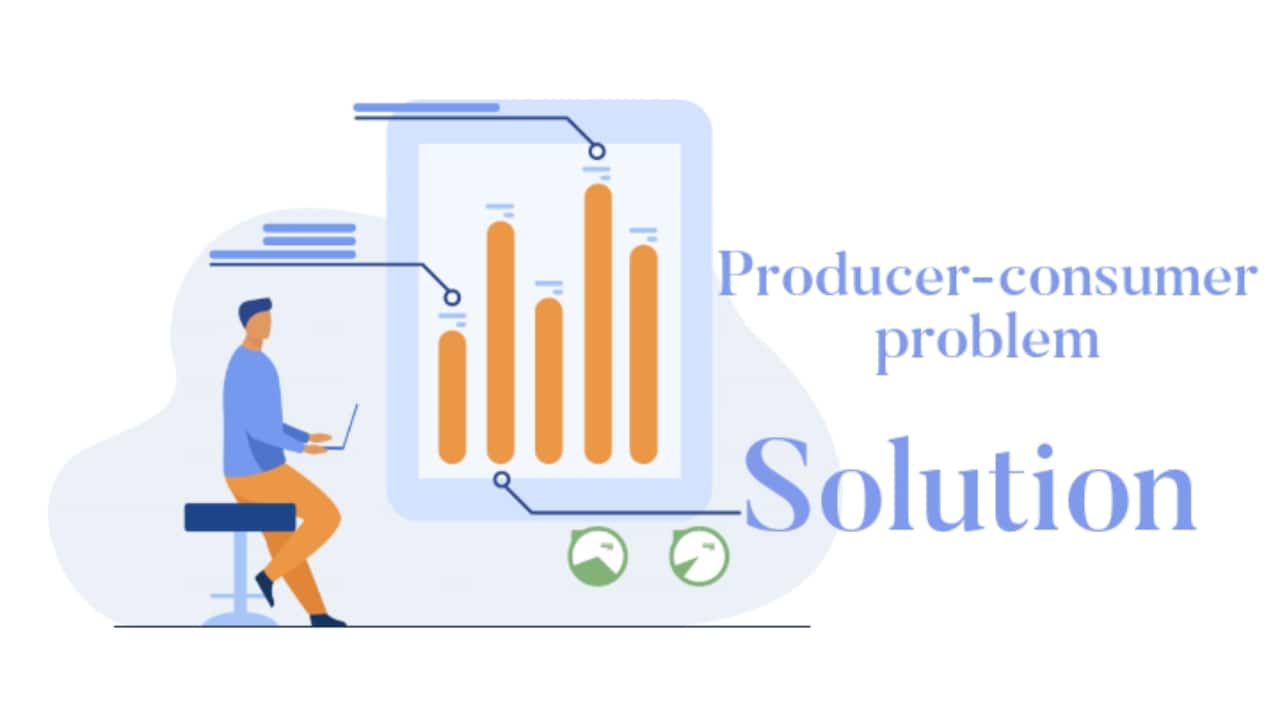Producer-consumer problem solution in OS

The Producer-Consumer problem is basically a problem that possibly happens in a multi-process environment. That is when there is a synchronization between two or more processes. Here you will get the Producer-consumer problem solution in OS using semaphores.
As it’s clear from the title, there is
- One Producer is generating data and putting it into a fixed-sized buffer.
- One Consumer takes the data generated by the producer from the buffer and consumes it at the same time.
- Both Producer and Consumer share the same memory (buffer) which is of fixed size.
- The Producer keeps on generating and putting the data into the buffer while the consumer at the same time, keeps on consuming that data generated by the producer.
Table of Contents
What the Problem is?
There are some of the problems that may occur in the synchronization of Producer and Consumer processes.
- When the buffer is full, logically, the producer shouldn’t generate more data to put it into the buffer. But it does. Rather it shouldn’t be allowed to generate data, in case, the buffer is full.
- Similarly, when the buffer is empty, the consumer shouldn’t come forward to consume data from the buffer, because it’s empty. If it does that, it’s just a waste of CPU processing. Rather, in the same way, it shouldn’t also be allowed to consume data if the buffer is empty.
- The third and the most important problem is that, both producer’s and consumer’s processing overlap with each other. i.e. when producer and consumer access the buffer at the same time, to produce and consume data respectively, there’s the possibility of some conflictions.
So, both the Producer and Consumer shouldn’t be allowed to access the buffer at the same time.
What’s the Solution?
We could solve all the above-mentioned problems with the help of Semaphores.
Now let’s have a look, how we can solve this.
In the producer-consumer problem, we can use the three variables of Semaphore:
- Semaphore S:
This semaphore variable helps to achieve mutual exclusion between different processes. With the help of this, we can restrict our buffer to be used/accessed by only a single process, either by the Producer or by the Consumer. In this way, at one time, either the data is being produced/generated by the Producer or being consumed by the Consumer. This variable will be initially set to 1.
- Semaphore E:
This variable is usually used to describe the empty space in the buffer.
At first, the buffer is empty that is no data is being formed by the producer yet, therefore the value of this variable will be “n” i.e. the whole empty space of the buffer.
- Semaphore F
This variable is usually used to describe the space that is occupied by the producer. Initially, the buffer is empty, so the value of this variable will be “0”.
Additionally, we’ll also be using the Wait() and Signal() system calls.
- the Wait()system call will decrease the semaphore variable by 1
- the Signal()system call will increase the semaphore variable by 1.
Producer-consumer problem solution
Producer Solution:
Now let’s have a look, how we can solve the Producer part in the Producer-Consumer problem:
- While() will be used to produce the data into the buffer again and again if it wants to.
- Produce() will be used to produce data.
- Wait(E) will be used to reduce the value of the “E” by 1 i.e., when the producer generates anything then there is a reduction in the value of the empty space in the buffer. If the buffer is full i.e. the value of the semaphore variable “E” is “0”, then the Producer process will stop producing more data into the buffer.
- Wait(S) is mainly used to set the variable of semaphore “S” to “0” so that no other method can enter into the critical unit.
- Append() function is used to append the newly produced data in the buffer.
- Signal(s) is used to set the semaphore variable “S” to “1” so that other processes can come into the critical section now because the production and appending of data generated by the Producer is now completed.
- Signal(F) will be used to increment the value of “F” by 1 because after adding the data into the buffer, one space is filled in the buffer and the variable “F” must increment.
See Also Blue Beetle (2023) Full Movie – Watch Online Free
Consumer Solution:
In the same way, we can resolve the Consumer part.
- While() will be used to consume data from the buffer again and again if it wants to.
- Wait(F) is used to decrease the semaphore variable “F” by one because if some data is consumed by the consumer then the variable “F” must decrement.
- Wait(S) is used to set the semaphore variable “S” to “0” so that no other process can enter into the critical section.
- Take() function is used to take the data from the buffer by the consumer.
- Signal(S) is used to set the semaphore variable “S” to “1”. So that other processes can come into the critical section now because the consumption and pulling of data from the buffer are now completed.
- Signal(E) is used to increase the semaphore variable “E” by one because after pulling the data from the buffer, one space is freed from the buffer and the variable “E” must increment.
Use() is used by the consumer to use the data taken from the
Hope you found a Producer-consumer problem solution. If you have any questions, feel free to ask.
See also What is pipelining?
Example of producer consumer problem in OS
Think of your favorite ice cream shop. The ice cream maker (producer) makes delicious ice cream and puts it in a big fridge. Customers (consumers) come to the shop and get ice cream from the fridge.
Now, imagine if the ice cream maker makes ice cream too fast, and the fridge can only hold a certain amount. If the fridge gets full, the ice cream can’t be kept there, and some might even melt. This is a problem!
In the computer world, sometimes programs create things (like ice cream) and others use them. We call them producers and consumers. But, like our ice cream, if the computer can’t keep up, it needs a way to manage it. That’s where the producer-consumer problem comes in.
It’s like making sure the ice cream maker doesn’t make too much ice cream before people can eat it. In computers, this helps programs share things without messing up.
So, the producer-consumer problem is like making sure everyone gets their ice cream before it melts, just like programs share data without problems on a computer!
Solving the Producer/Consumer Problem Using a Monitor
Imagine a factory where things are made, like toys. In this factory, some workers make toys (producers), and others pack them into boxes (consumers). But, we need to make sure that when a box is empty, the packer doesn’t try to pack it, and when a new toy is made, the packer doesn’t miss it.
To solve this problem, we use something called a “monitor.” Think of it as a traffic cop in our factory. The monitor makes sure that the producers and consumers work in order and don’t mess up.
Here’s how it works:
- A toy is made: When a producer makes a toy, it goes to the monitor and waits in line. This is like cars waiting at a red light.
- Packing the toy: The monitor lets the packer know that there’s a toy ready to be packed. The packer takes it and does the job. This is like the green light for cars to go.
- An empty box: When the packer uses up all the boxes, they tell the monitor, “Hey, we need more boxes!” The monitor goes and gets new boxes, so the packer can continue.
- Continuing the process: The producer and packer keep working in harmony because of the monitor, just like cars following traffic rules.
So, the monitor helps the workers do their jobs in the right order, making sure that toys are packed, and no one gets stuck without a box. This way, our factory runs smoothly, and we have lots of happy kids with toys to play with!




bookmarked!!, I like your web site!